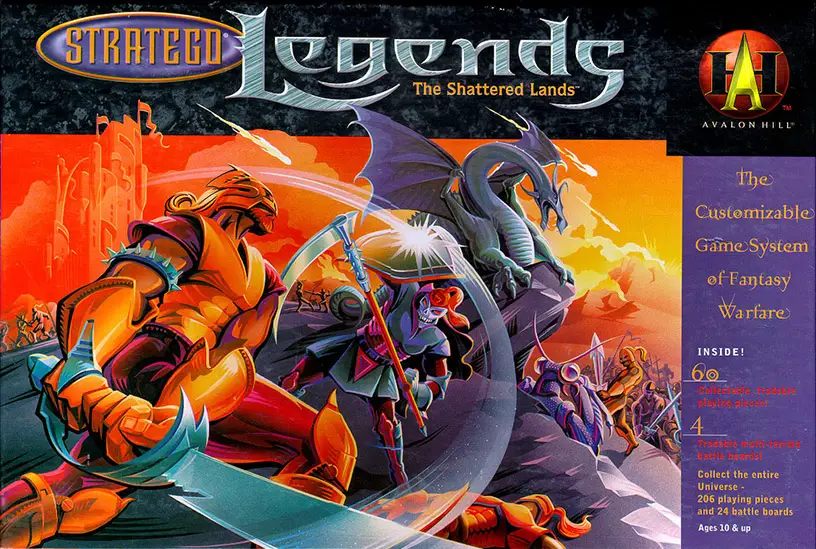
The Armies
The Valorians (beige)

A heroic race whose codes of honor are as long as their titles, the Valorians are comprised of noble knights, fearsome wizards and, and the clerics of the Grand Temple. But do not let their courtly ways and fine music fool you. Their true strenght is found on the field of battle, where epics are written and brave men create legends.
The Ancients (beige)

The original inhabitants of The Shattered Lands include elves, dwarves, and other people of the earth. The Ancients work the powers of the earth against their enemies. Their seers are the most powerful of magic workers and their attacks often come from nowhere - and everywhere.
The Celestia (beige)

Mysterious people of the winds, the Celestia are a race of beautiful reatures. This, however, does not make them any less deadly. their angles and spirits are embodiments of nature itself, and mythical beasts fight alongside them. Their sages lend their magic arts to the cause and protect the skies from the forces of evil.
The Gargans (grey)

The Gargans are a teeming army of belligerent beasts, ogres, giants and titans. Swords, fangs and whip are the weapons of choice and their shamans work magic that makes them even stronger.
The Manes (grey)

Under their blood-stained banner, the fiendish undead armies of the Manes terroize the countryside. Led by a race of dragonoids and influenced by necromancers who raise corpses and control spirits, the Manes feed on destruction and war itself.
The Qa'ans (grey)

Spawn of the depths, these beings resemble insects grown large. The Qa'ans are a rancid race of monstrous mutants. Mysterious warlocks harness new magic while illusionary beings, living slimes, and other strange mutations slither their way into battle. Who knows what their true motives are?
Setup
Put the 8 cardboard border pieces together.
Shuffle the 4 battle boards and randomly place them face down on the table. Take 2 battle boards and, without turning them over, place them in front of you.
Your opponent does the same with the other 2 battle boards. Then, simultaneously turn the 4 battle boards face up. Without rearranging them, place them inside the cardboard border.
Preparing for Battle
Choose an army: Decide who will control the beige army (Landor's Legions) and who will control the gray army (Kralc's Horde). If you cannot decide, hide a gray playing piece in one hand and a beige piece in the other hand. Your opponent chooses a hand and plays with the color army selected. The other color army is yours.
The beige player takes all the beige playing pieces. The gray player takes all the gray pieces.
Who goes first: Hide a gray piece in one hand and a beige piece in the other hand. Your opponent chooses a hand. If your opponent chooses your color, you go first and vice versa. When playing multiple games, let the player who lost the last game choose whether to go first or second.
Reference charts: Place the blue, green and gold reference charts in front of the player with the beige army. Place the silver, red and purple reference charts in front of the player with the gray army. These charts identify the abilities of your playing pieces.
Place your army: Sit opposite your opponent. Randomly place your 30 playing pieces label-side down on the two battle boards closest to you. Place one piece on each space except water spaces (the blue spaces). Your opponent does the same.
'Shuffle" playing pieces: Offer your opponent the chance to move any of your playing pieces while they are still label-side down. You may also move any of your opponent's pieces. This ensures that the placement of the pieces is truly random.
Stand up your playing pieces: Make sure the labels on your playing pieces face you.
Switch two pieces: The player who goes first may make up to 2 switches of liis/her owri playing pieces. (One switch means exchanging the location of 2 pieces). The other player may make up to 2 switches of his/her own playing pieces. Strategy hint: If your castle is in front of your army (close to enemy pieces), you may want to switch it with a piece in your back row.
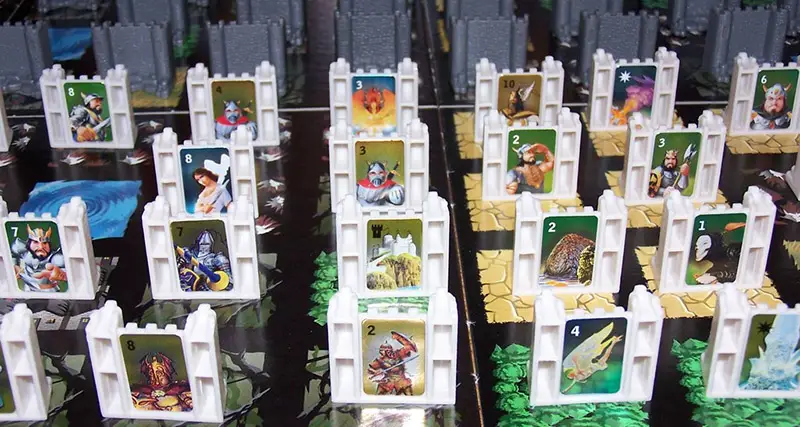
Object of the Game
To destroy or gain control of your opponent's castle.
Game Play
On your turn: You must move one of your pieces or perform one action. You and your opponent alternate turns.
Standard Movement
The following standard movement rules apply to all playing pieces except "stationary" playing pieces. (Stationary pieces are described on the reference charts as pieces that cannot move).
Important: Certain playing pieces hove powers that may contradict these rules. Each playing piece's powers are listed on the reference charts. When a contradiction occurs, the playing piece's power always takes precedence. In short, the power of o playing piece always supersedes the rules.
A playing piece may move one space at a time, forward, backward, or sideways.
A playing piece cannot move diagonally.
A playing piece cannot jump over another piece.
A playing piece cannot move onto a space already occupied by a piece under the same player's control.
A playing piece may move onto a space occupied by an opponent's piece. This move is called an attack.
A playing piece cannot move onto water (blue) spaces.
A playing piece cannot move back and forth between the same 2 spaces for more than 2 consecutive turns.
Attacking
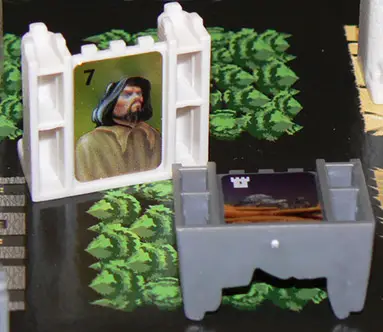
Whenever a playing piece moves onto a space occupied by an opponent's piece, the moved piece is attacking. At the end of the attack, none, one, or both pieces may be destroyed.
Whenever a playing piece attacks another piece, both pieces are immediately revealed. Both players may look at the reference charts to learn of any powers involved.
The strength numbers of the two pieces are compared (with numbers adjusted accordingly if there are powers that modify playing pieces' strengths). Once both players have made any adjustments to their strength numbers, the piece with the lower current strength number is destroyed.
If the numbers are equal, then both pieces are destroyed.
If a player attacks another player's Castle, the attacking player wins the game.
During an attack, if either of the playing pieces is a Magic piece, then the magic spell described on the reference chart is cast. (Most often the attacker is destroyed). Follow the instructions on the reference chart for each Magic piece. Also, see Magic Playing Pieces section below for further details.
Death Curses and certain adjacent playing pieces may also affect an attack. Pay close attention to what powers you can use to increase the strength of your piece. It is up to each player to know and remember all powers that are in effect. If you forget, your opponertt does not have to remind you.
Keep in mind that some powers go into effect only after a successful attack. If both attacker and defender are destroyed, it is not a successful attack for either piece.
Using your special powers
The following provides a detailed explanation of the special powers in this game and gives examples of each.
I. Innate Powers
An innate power must be used when indicated on the reference charts. You have no choice.
Examples of Innate Powers:
Berserk
A playing piece with Berserk is a killing machine. After this piece successfully attacks an enemy piece, it must attack another enemy piece if it is able to'do so. This continues until the Berserk piece loses an attack and is destroyed, or untii there are no pieces that it can attack. If a Death Curse is set off during an attack, it must be resolved before attacking again.
Dispel Magic
If a playing piece with Dispel Magic attacks a Magic playing piece, the Magic piece is destroyed and removed from the board without its spell being cast. (Magic pieces are described later in these instructions).
Other Innate Powers
Many playing pieces have innate powers that change their strength numbers or their opponents' strength numbers.
II. Abilities
There are many different abilities shown on the reference charts. Unless otherwise stated on the charts, you may choose to use an ability at any time. It may be used during your turn or during your opponent's turn. It may be used before or after you move. It may be used before or during an attack. Unless otherwise stated, an ability may also be used as many times as you like.
III. Actions
Many playing pieces also have a special power called an "action". Similar to an ability, an action often gives playing pieces special kinds of movement. However, an action may only be used on your turn, instead of making a standard move. Only one action may be used on your turn.
Examples of Actions:
Charging:
A playing piece with Charging may move any number of spaces vertically or horizontally (not diagonally) in one direction. It may not jump over pieces or pass over water spaces. It may end its move on a space occupied by an opponent's piece, thereby attacking it.
Slashing
A playing piece with Slashing may move any number of spaces diagonally in one direction. It may not jump over pieces or pass over water spaces. It may end its movement on a space occupied by an opponent's piece, thereby attacking it.
Quickness
A playing piece with Quickness may move 2 spaces vertically, horizontally or any combination. It may not move diagonally. If the first space on which it lands is occupied by an opponent's piece (causing an attack), it forfeits its second move. It may not jump over pieces or pass over water spaces. It may end its move on a space occupied by an opponent's piece, thereby attacking it.
Flying
A playing piece with Flying may jump over any number of adjacent playing pieces and/or water spaces in a straight line and land on the first empty space beyond. Flying must be done horizontally or vertically (not diagonally) in one direction. A piece may not use the Flying action to attack.
Distance Strike
A playing piece with Distance Strike is able to destroy an opponent's piece without moving onto the opponent's space. The Distance Strike piece may command any one piece up to two spaces away (horizontally, vertically, diagonally or any combination) to reveal itself.
If the revealed piece's current strength number is lower than that of the Distance Strike piece, then the revealed piece is destroyed. If it is equal to or greater than the Distance Strike piece, then nothing happens. If the revealed piece is a Magic piece or a Castle piece, then nothing happens.
Surround
A playing piece with Surround may allow a lower-numbered playing, piece to destroy a higher numbered piece. If an opponent's piece is adjacent to at least 5 pieces under your control and one of those pieces has the Surround actions then you may reveal your Surround piece to destroy your opponent's piece.
If the opponent's piece is a Magic piece, it is destroyed without its magic spell being cast. If the opponent's piece is a Castle piece, it remains unaffected.
Switching
A playing piece with Switching may trade places with another playing piece of the same type under your control. (For example, the spirit Almaetis could trade places with the spirit of Negation). Only one of the 2 pieces needs to have the Switching action, but both pieces must be revealed.
Teleport
If you have a playing piece with Teleport, you may destroy it to allow any other non-stationary piece you control to move to the destroyed piece's space. You must revegl the Teleported piece.
Vision
A playing piece with Vision may reveal itself to an opponent and then reveal one opponent's piece up to 2 spaces away, horizontally, vertically, diagonally or any combination.
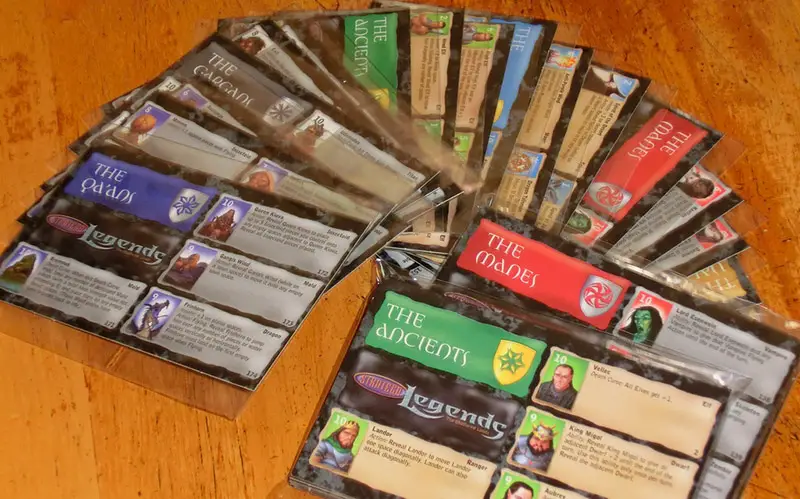
Magic Playing Pieces
Magic playing pieces are marked with a star * instead of a strength number.
Magic playing pieces have no base strength number and cannot be modified by powers that affect a piece's base strength number. They are also unaffected by the Distance Strike action.
Important: If a Magic playing piece is attacked, it is destroyed, thereby casting its magic. Follow the directions on the reference chart for any Magic piece that is destroyed.
Magic pieces provide the spells, magical creations and magical traps that both armies use while battling each other. Magic pieces may not attack and most of them are Stationary.
Note: If a playing piece with Dispel Magic attacks a Magic piece, then the Magic piece's magic is negated. In that case, the Magic-piece is destroyed without its magic spell being cast. The Dispel Magic ability does not work with Death Curses.
Castle Playing Pieces
Castle playing pieces have no base strength number and cannot be modified by powers that affect a piece's base strength number. They are also unaffected by the Distance Strike action.
If a Castle playing piece is attacked, it is destroyed and the game is over.
Pieces With Death Curse
Death Curses are long-term magical effects that can dramatically alter the outcome of a game. They are enchantments that operate beyond the grave. In other words, a Death Curse doesn't take effect until after the Death Curse playing piece is destroyed. Death Curses are not affected by the Dispel Magic ability.
If a playing piece with a Death Curse is destroyed, it is placed label-side up, out of play (away from the battle board), in a location you designate as the Death Curse Area.
The Death Curse is in effect until another Death Curse replaces it. If no other Death Curse is set off during the game, the first Death Curse remains in effect for the rest of the game. If another playing piece with a Death Curse is destroyed, then that piece is moved into the Death Curse Area and the new Death Curse takes effect.
The old Death Curse piece is moved into another location (away from the battle boards) that is called the Destroyed Pieces Area. There can only be one Death Curse in effect at any one time during the game.
Each Death Curse is different, but they all add powerful magic to the game. Some affect terrain, others help in combat. Some grant movement abilities, others weaken one color group. Some Death Curses grant (or suppress) powers and bonuses while they are in effect. Others grant powers only after they are replaced by another Death Curse. Be sure to read the reference chart description carefully to determine when a Death Curse actually takes effect.
If 2 or more playing pieces with Death Curses are destroyed at the same time, then none of the Death Curses go into effect.
If there is a Death Curse already in effect, it remains in effect. (The destroyed playing pieces are immediately placed in the appropriate Destroyed Pieces Area).
Remember: Any piece may be affected by a Death Curse, even if it has the Dispel Magic ability.
Death Curse Time
When a new Death Curse replaces an old Death Curse, make sure all directions for the old Death Curse have been followed before the new Death Curse takes effect.
Destroyed Pieces Area
When one of your playing pieces is destroyed, place it in your Destroyed Pieces Area.
Returing Destroyed Pieces
Certain powers described on the reference charts may allow destroyed pieces to return to battle. If you have the opportunity to bring a destroyed piece back into play, it cannot be a piece currently in the Death Curse Area.
Taking Control of your Opponent's Pieces
Certain playing pieces have powers that allow you to take control of your opponent's pieces. When using this power on an opponent, turn your opponent's piece around so that the image is facing you. While you control this piece, you may use any applicable power immediately. On future turns, you may move or perform any applicable action as directed.
Reducing an Opponent's Strength Number
There are playing pieces with abilities that reduce other pieces' strength numbers. Any piece that has been reduced to a strength number of 0 or below is immediately destroyed. No powers can be used to save a piece that has a current strength number of 0 or below.
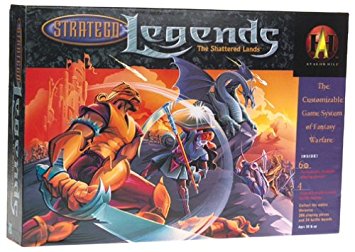
End of the Game
The first player to destroy or gain control of the other player's castle piece wins the game.
Note: If a player is unable to move any playing pieces or perform any actions, then the other player immediately wins the game.
Customize your Army
Customize your army to create a unique force under your control! Additional playing pieces may be obtained by trading with friends, purchasing additional games or buying Stratego Legends Booster Pocks.
You may also use different battle boards to create terrain combinations that work best with your new army. We suggest that beige and gray armies still remain separate. With careful thought, you might build an army that's nearly unstoppable. Of course, your friends may have the same idea.
Army Size
Both beige and gray armies must contain the same number of playing pieces and the same mix of base strength numbers. When customizing your army, it must contain the following:
Base Number Value Number of Pieces 10 1 9 1 8 3 7 3 6 3 5 3 4 3 3 3 2 3 1 1 Magic 5 Castle 1 Total 30 Customized Army Setup
When you battle with customized armies, the game setup changes slightly. Each player brings one army and 2 battle boards. Players place their 2 battle boards face down in front of them. Then each player randomly shuffles his/her opponent's boards.
All 4 battle boards are simultaneously turned face up and placed inside the battle boards' border as shown in Figure 3. Armies are then set up on the battle boards in the normal way.
Continue Reading


